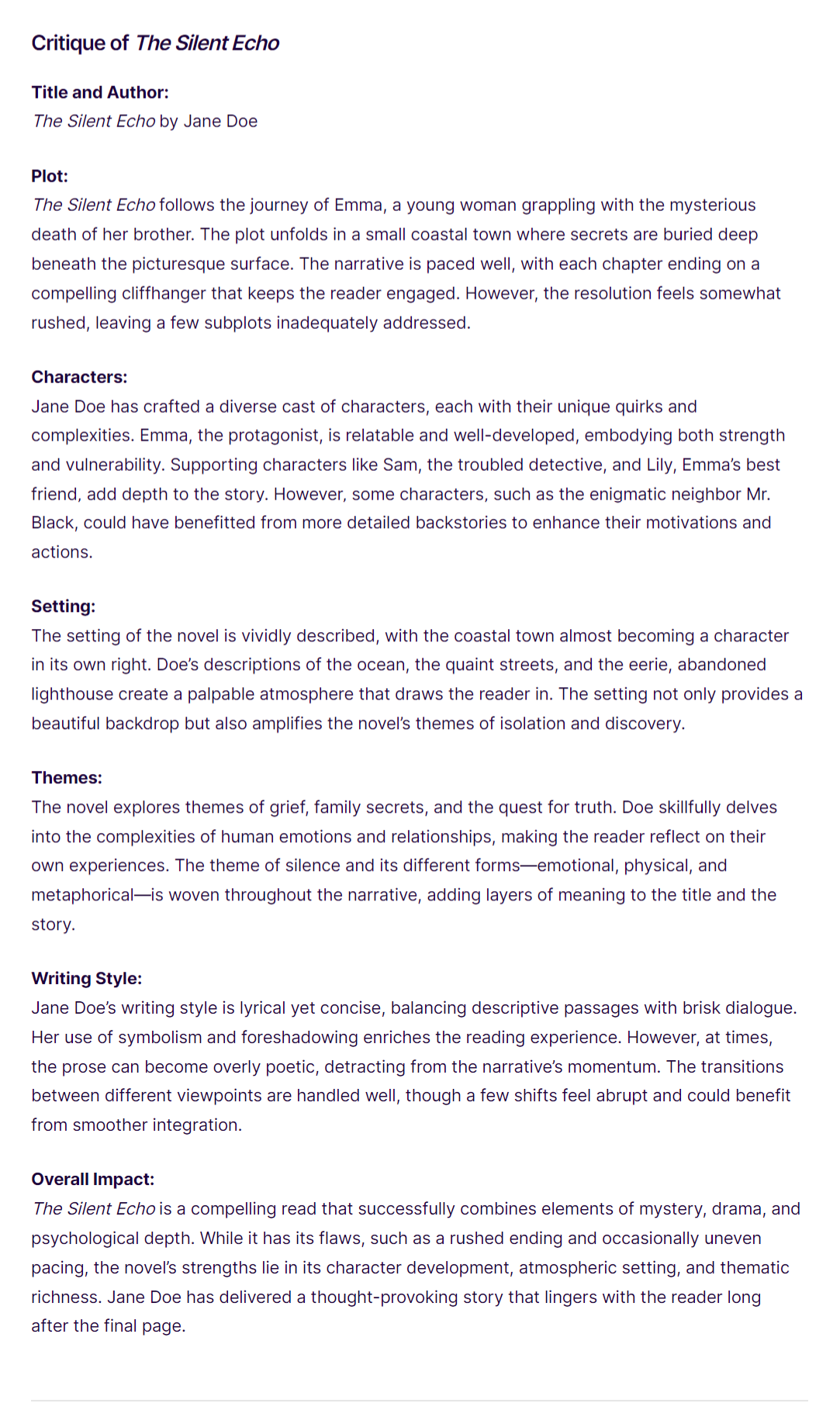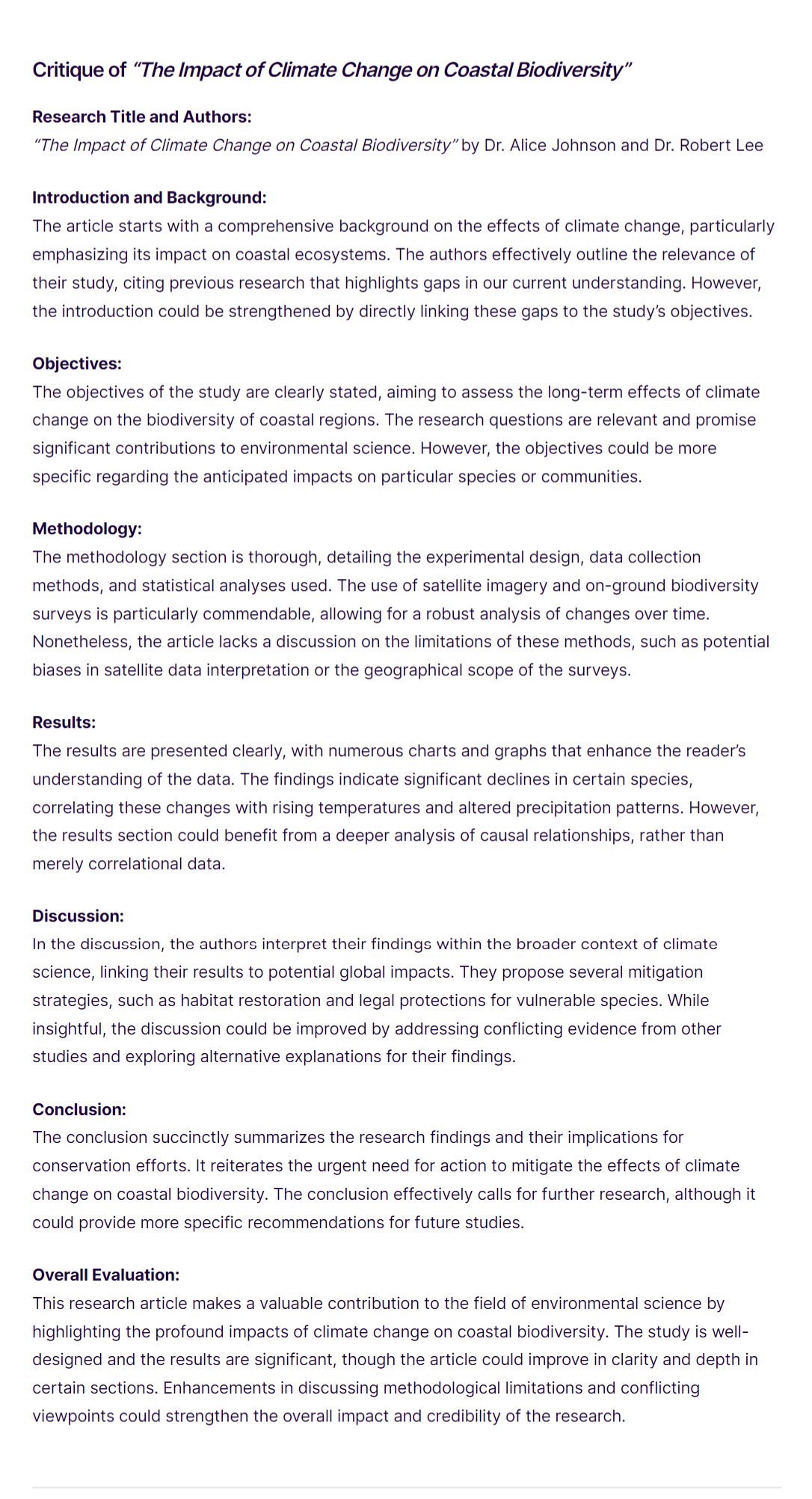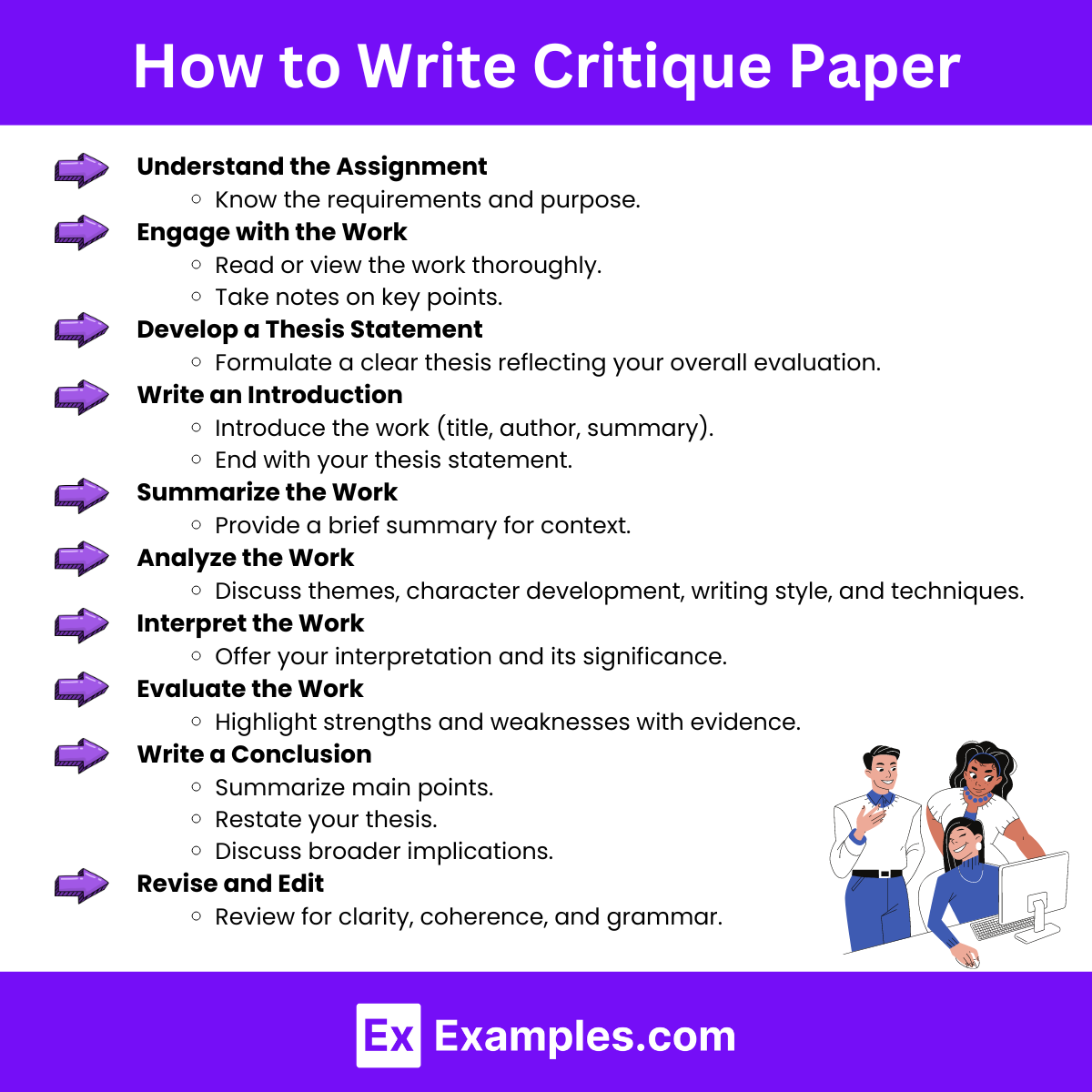15+ Critique Paper Examples
A critique paper is an analytical essay focusing on evaluating and interpreting a piece of work, such as an article, book, film, or painting. The aim is to assess the work’s strengths and weaknesses, often comparing it to relevant standards or other works in the field. The writer should provide a balanced analysis, supporting their observations with evidence, to inform readers about the work’s value and significance.
Critique Paper Free PDF Bundle
Free PDF DownloadWhat is a Critique Paper?
A critique paper is an analytical evaluation of a work, focusing on its strengths and weaknesses. It requires critical thinking to assess and discuss the work’s effectiveness and provide recommendations for improvement, often backed by evidence.
Types of Critique Paper
Critique papers can vary widely in focus and approach, depending on the subject and purpose. Here are some common types:
- Literature Critique: Evaluates books, articles, and other written materials, focusing on theme, style, and contribution to the field.
- Art Critique: Analyzes artworks in terms of technique, style, symbolism, and emotional impact.
- Film Critique: Examines films, discussing elements like narrative, directing, acting, and cinematography.
- Performance Critique: Reviews live performances such as plays, concerts, or dance shows, commenting on the performance, direction, and production values.
- Research Article Critique: Assesses scientific studies or academic research, focusing on methodology, data analysis, and the validity of conclusions.
- Business Critique: Looks at business practices, products, or company strategies to evaluate effectiveness and suggest improvements.
Purpose of Critique Paper
A critique paper serves several important academic and intellectual purposes, contributing to both the writer’s understanding and the broader scholarly community’s discussion on a subject. Here are the primary purposes of a critique paper:
- Analytical Thinking: Writing a critique paper encourages deep analytical thinking. It requires the writer to not only summarize the content of a work—be it a book, article, film, or art piece—but also to analyze its components critically. This process involves assessing the strengths and weaknesses of the work, understanding its structure, and evaluating its impact.
- Critical Engagement: A critique paper fosters engagement with ideas and arguments presented by others. Through critique, a writer interacts with the work’s themes, methodologies, and conclusions, providing a personal interpretation and positioning it within a larger scholarly context.
- Developing Arguments: One of the main goals of a critique paper is to develop and articulate a coherent and reasoned argument. The writer must present a clear thesis or main argument about the work being critiqued and support this thesis with evidence, logical reasoning, and systematic analysis.
- Enhancing Understanding: Writing a critique helps in deepening the writer’s understanding of the subject matter. By analyzing different aspects of a work and connecting them to broader themes and knowledge, the writer gains a more comprehensive insight into the topic.
- Scholarly Contribution: Critique papers contribute to academic discourse by adding to the diversity of interpretations and perspectives on a particular work or topic. This can influence how a work is understood in academic and professional fields, potentially leading to new insights and developments.
- Improving Writing and Research Skills: The process of writing a critique paper enhances a writer’s research and writing skills. It involves gathering information, synthesizing insights, formulating arguments, and composing a structured document—all essential skills in academic and professional settings.
- Preparation for Professional Activities: Especially in fields like literature, art, and film studies, critique papers prepare students and professionals to engage in critiques and discussions, which are common professional activities. This preparation can be crucial for career in academia, criticism, journalism, and beyond.
Critique Paper Format
A critique paper generally follows a structured format to ensure a thorough evaluation and clear presentation of thoughts. Here’s an outline of the typical format along with an example for a research article critique:
1. Introduction
- Background: Provide context for the work being critiqued.
- Thesis Statement: Present your main argument or overall impression of the work.
- Overview of the Work: Briefly describe the main points of the work.
Example:
In this critique, I evaluate the article “The Impact of Daily Exercise on Wellbeing” by Dr. Jane Smith, published in the 2020 edition of Health & Lifestyle. The article claims that daily exercise significantly improves mental health. This critique assesses the validity of Dr. Smith’s research methods and findings.
2. Summary
- Key Points: Summarize the main arguments, findings, or artistic elements of the work.
Example:
Dr. Smith’s article outlines a study conducted over 12 months involving 300 participants, exploring the effects of various exercise routines on mental health indicators such as stress, happiness, and overall life satisfaction.
3. Critique
- Methodology Evaluation: Analyze the methods used to determine their adequacy and fairness.
- Evidence Review: Discuss the evidence presented and whether it supports the claims.
- Bias and Limitations: Point out any biases or limitations within the work.
Example:
While Dr. Smith’s methodology of tracking participant wellbeing through self-reported surveys is insightful, the reliance on self-reporting can introduce bias and affect the reliability of the data. Furthermore, the study lacks a control group, which is crucial for comparing the effects observed.
4. Conclusion
- Summary of Critique: Recap your main points of critique.
- Final Assessment: Provide your final thoughts on the work’s overall validity and effectiveness.
- Recommendations: Suggest ways to improve or further areas for research.
Example:
In conclusion, although Dr. Smith’s findings provide valuable insights into the positive effects of daily exercise on mental health, the study’s methodologies could be strengthened by incorporating a control group and using more objective data collection methods. Future research should address these limitations to build on Dr. Smith’s work.
5. References
- Citation of the Work: Include all necessary citation information according to the academic style required.
Example:
Smith, J. (2020). The Impact of Daily Exercise on Wellbeing. Health & Lifestyle Journal, 15(4), 234-248.
Examples of Critique Paper
Here are the Examples of critique papers provide structured analyses and evaluations of various works, including books, films, and artworks. They illustrate how to critically assess themes, techniques, and overall impact.
Critique of a Novel

Critique of a Film

Critique of a Scientific Research Article

Critique Paper Examples for Students
Providing students with examples of critique papers can help them understand how to effectively analyze and evaluate different types of work, such as literature, films, research articles, and more. Here are three examples of critique paper topics, each tailored to a specific subject, that could be useful for students learning to write critiques:
- Critique of a Literary Work
- Critique of a Scientific Research Article: “Effects of Plastic Pollution on Marine Life”
- Critique of a Film: “Inception” Directed by Christopher Nolan
Critique Paper Examples for Short Story
Creating a critique for a short story involves analyzing elements such as plot, characters, setting, themes, and the author’s writing style. Here are three examples of critique papers for short stories that can help students learn to evaluate and interpret literature effectively:
- Critique of “The Lottery” by Shirley Jackson
- Critique of “Harrison Bergeron” by Kurt Vonnegut
- Critique of “The Yellow Wallpaper” by Charlotte Perkins Gilman
Feminist Critique Paper Examples
Feminist critique papers provide insightful analyses on literature, media, or cultural practices through the lens of feminist theory, highlighting issues of gender equality, representation, and the experiences of women. Here are three examples of feminist critique paper topics, each tailored to examine different subjects with a focus on feminist perspectives:
- Feminist Critique of “Pride and Prejudice” by Jane Austen
- Feminist Analysis of “Mad Men”: A Look at Gender Roles in 1960s America
- Gender and Power in “Game of Thrones”: A Feminist Perspective
Art Critique Paper Examples
Art critique paper examples offer structured evaluations of various artworks, including paintings, sculptures, and photographs. These examples analyze themes, techniques, and emotional impact, providing insights into the artist’s intentions and the work’s significance. They serve as guides for understanding and articulating critical perspectives on art.
- Critique of “Starry Night” by Vincent van Gogh
- Critique of “The Thinker” by Auguste Rodin
- Critique of “Migrant Mother” by Dorothea Lange
Critique Paper Examples for Books
Critique paper examples for books provide detailed analyses and evaluations of various literary works, including novels, non-fiction, and classics. They examine themes, character development, writing style, and overall impact, offering insights into the strengths and weaknesses of each book. These examples guide readers in developing their own critical perspectives.
- Critique of “To Kill a Mockingbird” by Harper Lee
- Critique of “Sapiens: A Brief History of Humankind” by Yuval Noah Harari
- Critique of “Pride and Prejudice” by Jane Austen
Critique Paper Examples for Novel
Critique paper examples for novels offer in-depth analyses and evaluations of fictional works across genres. They explore themes, character development, plot structure, and writing style. These examples help readers understand the novel’s strengths and weaknesses, providing a framework for developing thoughtful, balanced critiques of literary fiction.
- Critique of “1984” by George Orwell
- Critique of “The Great Gatsby” by F. Scott Fitzgerald
- Critique of “Beloved” by Toni Morrison
Characteristics of Critique Paper
A critique paper is a detailed analysis and evaluation of a work, such as a book, article, film, or painting. It goes beyond merely summarizing the work by also providing a critical discussion regarding the quality and impact of the work. Here are some essential characteristics of a well-crafted critique paper:
- Analytical Focus: A critique paper primarily analyzes and evaluates the subject matter rather than just summarizing it. It discusses what the work does, how it does it, and how effectively the purpose of the work is achieved.
- Evidence-Based: Critiques are not just based on opinion; they are supported by evidence from the work itself. This might include quotations, examples, and detailed observations that back up the critique’s claims and conclusions.
- Balanced Argumentation: While it’s important to discuss what you perceive as the weaknesses of the work, a good critique also acknowledges its strengths. This balanced view helps to avoid bias and gives the paper credibility.
- Clear Structure: Like any formal piece of writing, a critique paper should be well-organized. It typically includes an introduction that states the work being critiqued and the main points of the critique, a body that discusses each point in detail, and a conclusion that summarizes the critique and may suggest broader implications or future directions.
- Critical Perspective: The critique should offer a distinct perspective that reflects critical thinking. It should engage with the work’s themes, techniques, and impact, providing a deeper understanding or new insights that go beyond the surface.
- Contextual Awareness: A critique considers the work in its broader context. This might include the historical, cultural, or academic context of the work, discussing how these elements influence the creation and reception of the work.
- Objective Tone: While personal responses can be included in a critique, the tone should remain objective and professional. The critique should focus on the work itself and its merits or faults, rather than on the author or creator as an individual.
- Thesis Statement: A strong critique paper features a clear thesis statement that guides the analysis. This statement typically outlines the main argument or viewpoint of the critique and sets the tone for the discussion.
- Engaging Writing: Effective critiques not only provide insights but are also engaging to read. They use persuasive language to make their points and maintain the reader’s interest throughout the paper.
- Reflective Insight: Beyond evaluating the work, a critique often reflects on its significance within a larger context or discipline. It may discuss how the work contributes to ongoing debates, trends, or theories within the field.
How to Write Critique Paper

Writing a critique paper involves a systematic analysis of a work (like an article, book, film, or painting), focusing on evaluating its various components and expressing your point of view. Here’s a structured guide on how to write a high-quality critique paper that’s SEO-friendly and well-suited for readability:
Understand the Assignment
Before you start writing, make sure you fully understand the requirements of your critique. Know whether you need to provide a general analysis or focus on a specific aspect of the work
Read or View the Work
Engage with the work thoroughly. If it’s a book or an article, read it multiple times. For films or exhibitions, consider multiple viewings. Take notes on key points, themes, and elements that stand out.
Develop a Thesis Statement
Your thesis is the central argument of your critique. It should state your main point clearly and concisely, expressing your overall opinion of the work. For instance, “John Doe’s ‘Modern Society’ effectively argues its point about social media addiction through compelling data and relatable personal stories, though it sometimes lacks sufficient counterarguments.”
Write an Introduction
Start with an engaging introduction that provides essential information about the work (title, author, type of work, and publication date) and ends with your thesis statement. This section sets the stage for your critique.
Summarize the Work
Briefly summarize the main points of the work to provide context for your analysis. Keep this part factual and neutral, covering key points that are relevant to your critique without going into excessive detail.
Critically Analyze the Work
In the body paragraphs, discuss your analysis of the work, supporting your thesis with evidence. Break down your critique into organized sections, such as:
Content Evaluation: Analyze the accuracy, depth, and relevance of the information presented.
Structure: Evaluate the organization and clarity of the work.
Style: Consider the author’s writing style, use of language, and the appropriateness for the intended audience.
Impact: Discuss the effectiveness and impact of the work on its audience.Use Effective Transitions
Smooth transitions between paragraphs help guide the reader and improve the flow of your essay. Use transitional words and phrases to connect ideas.
Conclude Your Critique
Summarize your points briefly and restate your thesis in a new way in the conclusion. You might also discuss the broader implications of the work or suggest areas for further research or consideration.
Revise and Edit
Ensure your critique is clear and concise. Check for grammar and spelling errors, and make sure your arguments are logically structured. Compliance with SEO standards such as using familiar words, maintaining appropriate sentence length, and avoiding passive voice will enhance the readability and effectiveness of your critique.
Cite Your Sources
If you’ve used additional sources to support your critique or to understand the work, make sure to cite them appropriately to avoid plagiarism.
What is a critique paper?
A critique paper analyzes and evaluates the quality and significance of a work, such as an article, book, film, or painting.
How do I start a critique paper?
Begin with an engaging introduction that includes the work’s basic information and your thesis statement expressing your main evaluation.
What should be included in the body of a critique paper?
The body should include your detailed analysis, supported by evidence from the work, covering content, structure, style, and impact.
How do I conclude a critique paper?
Summarize the main points, restate your thesis in a new light, and possibly suggest areas for further research or implications.
How long should a critique paper be?
The length varies based on assignment requirements but typically ranges from 500 to 2000 words.
Do I need a thesis statement for a critique paper?
Yes, a clear thesis statement is crucial as it guides your analysis and states your overarching opinion of the work.
Can I include personal opinions in a critique paper?
Yes, personal opinions are valid as long as they are supported by evidence and reasoned analysis.
How do I cite sources in a critique paper?
Use the citation style specified by your instructor, typically APA, MLA, or Chicago, to cite all referenced materials.
What is the difference between a critique and a summary?
A critique offers a detailed evaluation and analysis, whereas a summary only provides a concise recap of the work’s main points.
How can I make my critique paper stand out?
Offer unique insights, engage deeply with the text, and provide a balanced evaluation that includes both strengths and weaknesses.



